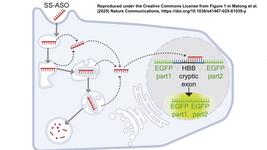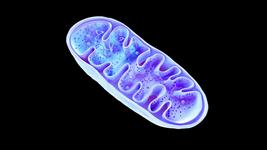CMN Weekly (1 April 2022) - Your Weekly CRISPR Medicine News
By: Gorm Palmgren - Apr. 1, 2022
Top picks
- Researchers at InBio have used CRISPR-Cas9 to knock out the major cat allergen, Fel d 1. Experiments were performed in vitro and yielded up to 55% editing efficiencies with no evidence of off-target sites. The study found that Fel d 1 may be nonessential for cats and suggests the approach as a promising route to developing a hypoallergenic cat.
- Researchers in Sweden and elsewhere have used CRISPR-Cas9 to partially restore the amyloid-β 42/40 ratio in human fibroblasts carrying the early-onset Alzheimer's disease presenilin 1 (PS1) M146L mutation. In addition, the researchers were able to disrupt more than 50% of mutant alleles without any detectable editing at the highest-ranking candidate off-target sites.
Research
- Cas9 can tolerate the inclusion of universal bases that serve as wildcards in individual gRNAs, enabling simultaneous targeting of polymorphic sequences. This is shown by Canadian researchers who demonstrate the applicability of this technology to targeting multiple naturally occurring human SNPs with individual gRNAs.
- In a non-reviewed paper, UK scientists report a CRISPR gene editing approach for treating Alzheimer's disease (AD) that enhances the clearance of amyloid-beta (Aβ). The authors used CRISPR to introduce a rare coding variant, P522R, in the phospholipase C gamma 2 (PLCG2) gene that is known to be protective against late-onset AD. In vitro edited microglia cells increased clearance of Aβ while protecting synapses in cell culture systems.
- CRISPR-Cas9 has been used to attenuate intervertebral disc degeneration in vivo in a mouse model of disc injury. The American scientists targeted β-catenin, a pivotal factor associated with disc degeneration, through intradiscal injection of CRISPR-Cas9-expressing adeno-associated virus. This led to the downregulation of β-catenin and several positive multifaceted therapeutic effects on disc degeneration.
- Swiss scientists have used CRISPR-Cas9 to silence chondrocyte inflammatory signals for tissue-engineered cell therapy in osteoarthritis. The researchers knocked out Tak1, a Map kinase responsible for the signal cascade of inflammatory stimuli in the NFKB pathway, using a bovine cartilage ring in vitro model.
- A study by American researchers suggests that the gRNA vector dose determines the outcome of systemic adeno-associated virus (AAV) CRISPR therapy for Duchenne muscular dystrophy (DMD). The gRNA to Cas9 vector genome copy ratio was optimal at 3:1, showing significantly higher dystrophin expression and genome editing, better myofiber size distribution, and a more pronounced improvement in muscle function and electrocardiography in the mdx mouse model of DMD.
- Researchers in South Korea have improved the efficiency and specificity of the CRISPR-Cas12a system through protein and crRNA engineering. They used a chimeric DNA-RNA guide chemically similar to crRNA to maximise target sequence specificity. Moreover, using an enhanced Cas12a system (en-Cas12a) improved the efficiency and target specificity almost three times.
- CRISPR-mediated base editing is suggested as an efficient approach to silence the Hepatitis B virus (HBV) S gene and potentially eliminate HBV. The Chinese scientists used lentivirus to deliver cytidine base editors to human hepatoma cells carrying the HBV genome, where they generated a premature stop codon in the S gene. This led to a 92% reduction of HBV surface antigen secretion in edited cells.
- German researchers present a so-called hei-tag (high efficiency-tag) that boosts the activity of CRISPR-Cas genome editing tools when supplied as mRNA. The hei-tag consists of a myc tag coupled to an optimised nuclear localisation signal via a flexible linker. Its addition increases bi-allelic editing while still reducing allele variance.
- Chinese scientists have established an imperfect gRNA (igRNA) base editing methodology, which utilises a gRNA with one or more bases that are not complementary to the target locus. This approach significantly increased the single-base editing fraction relative to standard gRNA editing with increased editing efficiencies for cytosine and adenine base editors.
- A highly sensitive CRISPR-based on-chip optic approach for clinical gene analysis of inherited diseases is presented by researchers in China. The sensor included immobilised dCas9 and was demonstrated to detect Duchenne muscular dystrophy exon deletions in clinical samples, yielding significantly positive results within 5 min.
- Chinese researchers have released an online repository of anti-CRISPR proteins (Acrs) called Anti-CRISPRdb v2.2. It includes information on inhibitory mechanisms, activities and neighbours of curated anti-CRISPR proteins. The repository shows several improvements to previous databases, including more entries and families and the prediction of Acr neighbours and proteins to be Acrs.
Industry
- Integra Therapeutics has closed an additional €1.5-million investment on top of the €4.5 million raised last December. The new funds will support the development of the FiCAT platform prototype that combines CRISPR-Cas9 and PiggyBac transposase technologies and preclinical validation with in vivo and ex vivo models.
- Cytosurge has established a CRISPR cell line engineering service, FluidFM CellEDIT, especially suited for hard-to-transfect and rare cells. The service utilises the company's FluidFM technology that combines microfluidics with force control for gentle injection of any soluble cargo into single cells.
- Prime Medicine and Myeloid Therapeutics have entered a partnership to accelerate the development of Myeloid’s proprietary RNA-based, retrotransposon mediated gene-insertion technology, RetroT, which has applications in gene editing and delivery and may be complementary to prime editing.
Detection
- Spanish researchers have developed a new biosensor, CASCADE, that combines Cas13a and gold nanoparticles for naked-eye colourimetric detection of SARS-CoV-2 RNA. Upon target recognition, Cas13a cleaves ssRNA oligonucleotides conjugated to gold nanoparticles, thus inducing their colloidal aggregation, which can be easily visualised.
- The rapid and sensitive detection of Salmonella typhimurium is described using electrochemical sensing based on CRISPR-Cas12a and hairpin DNA probes. The method was developed by Chinese researchers and could detect S. typhimurium in spiked poultry meat with excellent accuracy and sensitivity.
Reviews
- German and Swiss researchers discuss basic research and clinical application of CRISPR-Cas-based human T cell engineering in a comprehensive review. Among the topics covered are the generation of knockout and knock-in mutants and base and prime editing applications.
- A meta-analysis by Chinese scientists concludes that for COVID-19, the diagnostic performance of CRISPR is close to the gold standard. The meta-analysis included 5,857 patients from 54 studies and found the pooled sensitivity and specificity to be 0.98 and 1.00, respectively. In addition, detection assays based on Cas13 were slightly more sensitive than Cas12-based methods and marginally less specific.
- Researchers in Greece look at CRISPR–Cas9 gRNA efficiency prediction and give an overview of predictive tools and the role of deep learning. They discuss the approaches to the on-target activity problem, focusing mainly on the features and computational methods they utilise.
- In a non-peer-reviewed review, Chinese researchers discuss CRISPR's potential applications to cure COVID-19. Among the suggested possibilities are degrading the viral RNA to terminate the infection, or refining the specificity and safety of CAR-T cells, CAR-NK cells and neutralising antibodies against SARS-CoV-2.
- Researchers from China look at CRISPR-Cas12a-based systems as powerful tools for biosensing in food safety. The authors emphasise that the system can be adjusted and reconfigured within days to detect other targets in food safety and that the future development of portable microfluidic devices holds great promise for multiple detections.
- The application of CRISPR-Cas systems for the individualisation of cancer precision medicine is the subject of a review by researchers in India. The authors look at the latest developments in the field in terms of optimising the performance of the CRISPR-Cas elements and how this can fuel greater application in precision medicine.
- A review by Russian scientists looks at the problems with poor delivery efficiency and low editing efficacy in CRISPR-Cas systems. They discuss the use of Cas protein and sgRNA ribonucleoprotein complexes (RNPs) to mitigate this problem and the types of in vivo delivery methods for RNPs that have been developed.
- American scientists discuss how CRISPR diagnostics have recently emerged as powerful diagnostic tools for rapidly detecting infections. In addition, they outline recent developments and advancements in CRISPR diagnostics that have pushed these technologies to the point of care.
- An editorial in Expert Review of Respiratory Medicine looks at the possibilities for CRISPR gene editing for respiratory medicine. The author discusses the clinical potentials for lung cancer and COVID-19 and technical issues like off-target effects, delivery methods, base editing and epigenetic editing.
- Polymer-based transfection agents used in CRISPR-Cas9 systems are the topic of a review by researchers in Turkey. The review presents the latest information about current studies related to polymeric carriers used in non-viral CRISPR delivery systems.
- Researchers in Ireland have reviewed the recent advances, challenges, and prospects in pathogen detection on microfluidic platforms. They discuss ways to help minimise contamination and stability issues and the impact of compatible and challenging aspects of individual assay methods.
Opinions and perspectives
- In a viewpoint, American scientists discuss the potential of CRISPR-Cas-based functional genomics for neurogenerative diseases. Among the problems in this area is that these diseases are usually multigenic, and in Parkinson's disease, at least 90 independent variants for risk and progression are known.
News from CRISPR Medicine News
- Monday's feature article described how a Brazilian research team had developed a method for nasal delivery of CRISPR reagents that overcomes the brain-blood barrier. The researchers used the technique to insert an intact IDUA gene in brain cells and improve mice's cognitive symptoms of mucopolysaccharidoses (MPS I). Experiments will proceed with monkeys later this year.
- Wednesday's clinical trial update looked at Graphite Bio's sickle cell disease candidate GPH101. GPH101 is an ex vivo CRISPR-edited cell therapy that is anticipated to provide a permanent cure by targeting the root cause of the disease.
To get more of the CRISPR Medicine News delivered to your inbox, sign up to the free weekly CMN Newsletter here.
Tags
CLINICAL TRIALS
IND Enabling
Phase I
Phase II
Phase III
Recurrent or Progressive High-grade Glioma, (NCT06737146)
Sponsors:
Suzhou Maximum Bio-tech Co., Ltd.
Sponsors:
Suzhou Maximum Bio-tech Co., Ltd.
IND Enabling
Phase I
Phase II
Phase III
Advanced Peritoneal Malignancies or Abdominal Metastatic Solid Tumors, (NCT06912152)
Sponsors:
Zhejiang University
Sponsors:
Zhejiang University
IND Enabling
Phase I
Phase II
Phase III







